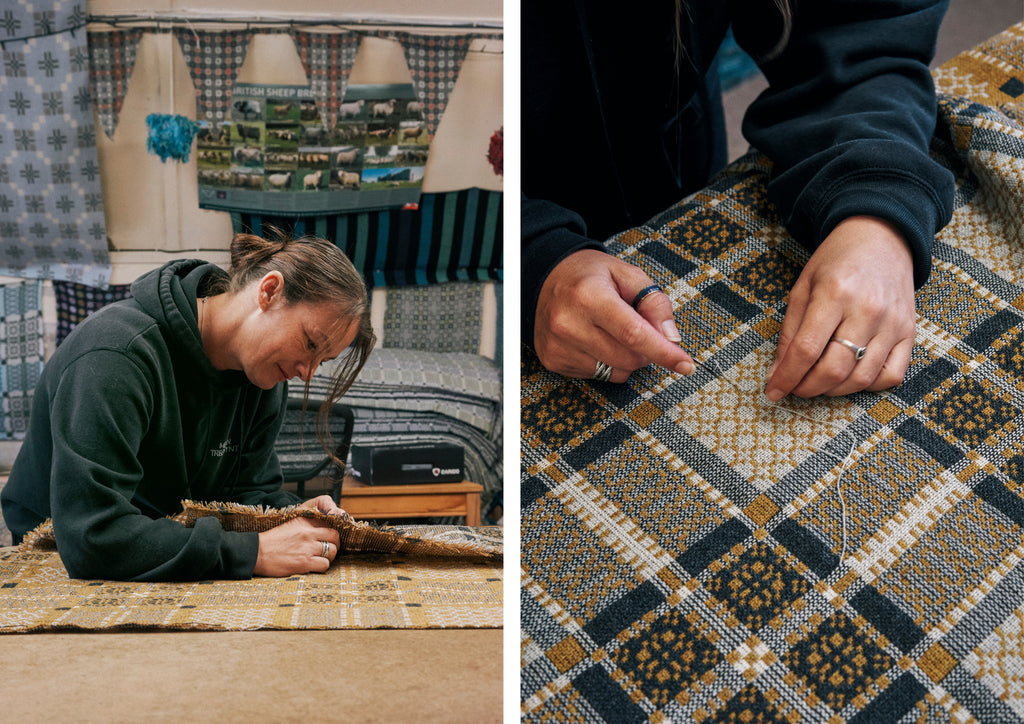
Down winding lanes dappled with shade from wild, overgrown verges is Melin Tregwynt, a woollen mill on the Pembrokeshire coast in Wales. The site has been home to a working mill since 1819 and was originally used to mill corn. Melin Tregwynt began to process wool towards the end of the century, and today the weaving room remains full of looms creating distinctive double-cloth fabrics rooted in the long tradition of Welsh textiles.
“My first memory of the business is wondering why there were all these people in the house,” Eifion Griffiths, whose grandfather Henry bought the mill in 1912, says. He remembers watching his father working in the mill, and his mother in the shop, which was in the parlour room at the front of his childhood home. Until a few months ago, the mill was owned by Eifion and his wife Amanda. In 2022, to mark the 110th anniversary of his family purchasing the mill, the company evolved into an employee ownership trust, with benefits shared equally between each of the 42 employees.

“There aren't that many mills left in Wales, they tend to be small family businesses,” Eifion explains. “People are getting older, and there often isn’t anyone to take over.” He has seen other Welsh companies bought by larger enterprises and understands the importance of your heart being in the business. Eifion’s father began working at the mill aged 14. He became a very good businessman, and in his later life took great pleasure in packing up parcels of finished pieces. “He was great at it, bundling up blankets in paper and tying them with string.”
I’m led through the time-worn buildings by Sophia Watts, textile designer and production planning manager. Sophia creates new patterns and variations on traditional weaves in new colours, such as a blanket exclusively created for TOAST in coal, mead, ash and white wool from Yorkshire-based yarn supplier Knoll. The pattern, Knot Garden, is from Melin Tregwynt’s archive and traces back to the 1950s. One of Sophia’s long-term projects is organising their collection of cloth fragments – which range from small swatches to entire blankets – drawings and paper patterns. “When I started here 15 years ago, we were working with much more contemporary patterns, but today the vintage ones are much more popular,” she explains. The appeal of Knot Garden lies in its intricacy. “It’s not as simple as choosing two colours that you think will go together,” Sophia says. “The colours blend together at different parts of the weave, creating interesting effects. It’s about the way they interact – they need to really sing.”


To create a fabric, first the warp is created over two days in the weaving room. Then, the warp will be tied to one of their five looms by hand over another two days – for the Knot Garden pattern, there are over 3000 ends. “It’s very labour-intensive,” says James Lamb, the mill manager. “Accuracy is very important, especially with tying in.” If a mistake is made, it all has to be undone. After it has been tied in, it is woven in 25 metre pieces, which each take around four hours. “In a day, you’d hopefully get around 50 metres off a machine,” he says. Then, it is mended, and sent away to Scotland to be finished, before it returns and is sewn into blankets.
In the mending room, Paula Harding and her mother Aelwen work away, their familiar chatter a welcome contrast to the rumble of the looms. They meticulously check over each piece of cloth looking and feeling for irregularities in the weave. Paula shows me a thread missing in a double-cloth fabric, barely visible to an untrained eye. “Sometimes they snap, so we weave them back in by hand like this,” she explains, turning the fabric over to reveal the contrasting side of the weave and working the needle in and out. “You probably find half a dozen knots,” Aelwen says, “and one or two broken threads.” Aelwen learnt how to mend from her mother Jean, who worked alongside her for nearly 20 years, and the tricks of the trade have now been passed down to Paula, the third generation of the family to work at the mill. The broken threads can run for two metres, while the knots, she explains, are the result of multiple cones of yarn being tied together.

Looking at the intricate patterns, two metres of mending by hand appears impossible. “Some of the weaves are more fussy,” Aelwen says. It also depends where it is – if the break is in the middle, flipping the cloth over is more difficult; fortunately, the section Paula is mending is just at the edge. Dozens of cones of yarn in different shades sit on a table behind them, each waiting to be matched to a warp or weft, while samples of cloth hang from the walls, all memories of past textiles to pass through their hands. The largest mend Paula remembers was in the middle of a piece of cloth 25 metres long and 3 metres wide. “I can’t look at that fabric now,” she says with a laugh. “People don’t see what we see,” says Aelwen. “We get a lot of satisfaction in making things right.”
Interview by Alice Simkins.
Photographs by Marco Kesseler.
Eifion wears our Garment Dyed Herringbone Jacket.
Shop our Melin Tregwynt Welsh Blanket in Mead/Ash and Indigo.
Add a comment
16 comments